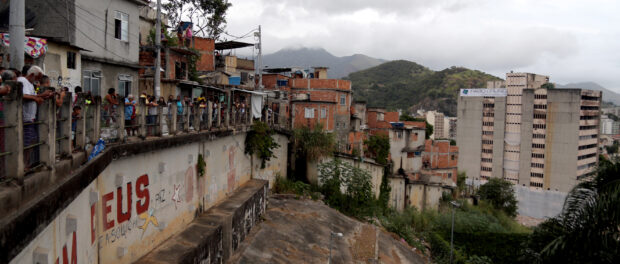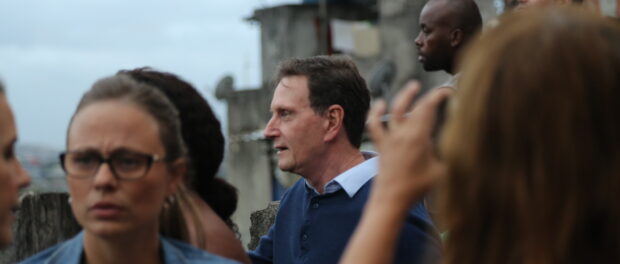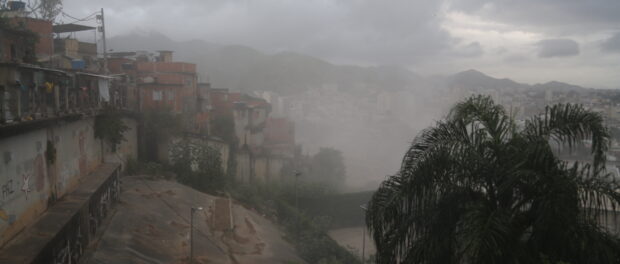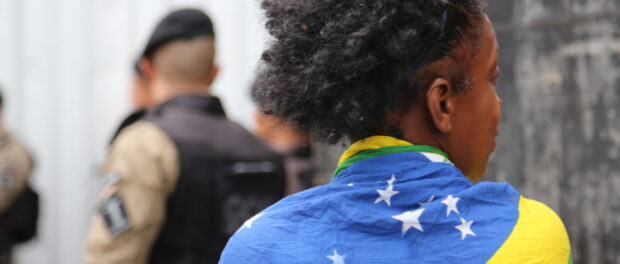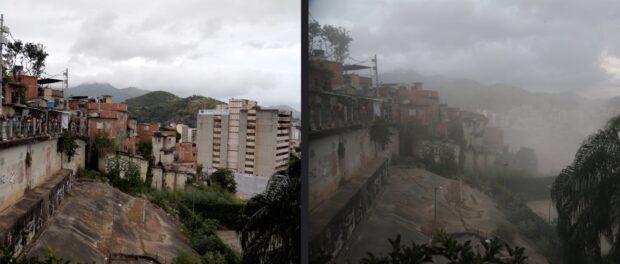
This is the first article in a two-part series on the demolition of the former IBGE (Brazilian Institute for Geography and Statistics) building. Check back tomorrow for Part 2.
Mayor Crivella says slave quarters have fallen
On Sunday May 13, the 130th anniversary of the abolition of slavery in Brazil, the former IBGE (Brazilian Institute for Geography and Statistics) building in Mangueira, in Rio de Janeiro’s North Zone, was demolished. The building had been occupied by approximately two hundred otherwise homeless families since the late 1990s. Mayor Marcelo Crivella promised that a Minha Casa Minha Vida public housing unit with 320 apartments would be constructed in the same area to rehouse the families.
Crivella’s choice of this symbolic date for the demolition was no coincidence. After he himself had pressed the button to trigger the explosives that transformed the building into ruins, he made a speech comparing the demolition with the abolition of slavery. “May 13 is not just Mother’s Day; it’s also the day when the slaves were liberated. And today another senzala (slave quarters) has fallen, perhaps one of the last ones to fall in Rio. It’s gone. The Mangueira senzala has gone. For 25 years many slaves lived here. There’s no other way to describe it. These people were living in the shadows, without water and without electricity, just like in a senzala.”
Crivella’s speech was the apex of a media strategy of questionable taste which, since the demolition of the building was first announced, has used heavy, populist images—images that are both ethically problematic and lacking in socio-historical accuracy—to show his supposed engagement with affordable housing and social justice. But what’s really behind the dubious symbols and analogies used by Crivella?
The spectacle of the IBGE demolition
At 7am on the anniversary of abolition day, hundreds of Mangueira residents gathered at viewpoints and on rooftops, anxiously watching the old IBGE building which, since being abandoned in 1997, had provided housing for hundreds of homeless families. From a rooftop with an unrivaled view of the scene, the mayor pressed the detonator to ignite 150 kilograms of explosives inside the building. Within a few seconds, amidst a mixture of shouts, cries, and applause from the crowds, the twelve-story building collapsed in an extraordinarily cinematographic scene, creating a dense cloud of dust that covered the whole favela in a brown layer.
The impressive visual nature of the old IBGE building (from before the demolition through to its collapse) was certainly a decisive factor in the mayor’s choice of this particular occupation, and not others, to showcase his supposed engagement with the issue of affordable housing. Since April 14, when Crivella traveled to the building to announce its demolition, there had been a prolific amount of media fanfare stoked by the mayor’s office. In his speech on that day, the mayor referred to the building as a “cursed monument to contempt, to our inequality, to all that is bad in our city.” In addition to the building’s imposing architecture and height, its insalubrious conditions made for compelling visuals; before the demolition 856 tons of garbage were removed from the building in which families, animals, and the drug trade had coexisted. These visual elements contributed to the building becoming a very powerful media tool. The City released spectacular drone footage showing the demolition. The video footage leaned heavily on the dramatic nature of the event, focusing not only on the building but on the precarious lives of the its residents. This video, for example, shows a former occupant seemingly overcome with emotion upon receiving a rent subsidy check for R$400 from the City, as a piano background track adds dramatic effect reminiscent of telenovelas.
“The Mangueira senzala has fallen”
Given the mediatic build-up to the events of May 13, the mayor’s comparison of the end of slavery in Brazil and the demolition of the old occupation was not at all surprising. Listening to Crivella speak, one could picture him as a modern-day Princess Isabel who, through a rent subsidy check and a Minha Casa Minha Vida project, claimed to be liberating the former occupants or, to use his words, allowing them to “restart their lives with dignity.” Crivella’s speech was extremely problematic for several reasons. By comparing the occupation to a senzala and calling the occupants “slaves,” Crivella demonstrated a tremendous lack of sensitivity and respect not only towards the former residents who he had brutally evicted from the building on April 27, but also towards the history of black Brazilians. The mayor’s choice of the word “slaves” to describe citizens, as well as being a powerful image aiming to capture the public’s imagination, has undeniable ethical implications. Given that Crivella is an elected representative and that he chose to invoke this dark period of Brazilian history, it is important he take responsibility for what it means to use this word.
It is essential to recognize slavery’s pernicious legacy, which continues today through systemic racism and social inequality in Brazil. However, Crivella’s reference to the past doesn’t seem to have come from this critical perspective. On the contrary, his use of the words “slaves” and “senzala” conjures up morbidly folkloric images suggesting a passive, nonhuman, and miserable definition of enslaved black Brazilians (and by comparison, the former occupants of the IBGE building).
The senzala comparison was based on Crivella’s statement that in the IBGE building “these people were living in the shadows, without water and without electricity.” Again, Crivella used a simple image, speaking about the visual aspect of things without going deeper into the social meaning. The senzala never existed without the casa grande—the master’s house. And Africans could never have been enslaved without the masters, traders, and exploiters of a free workforce. Nobody was ever naturally a slave. Black and indigenous peoples were enslaved within a slave-owning society that involved all social classes. So if it’s that easy for Crivella to point to a group of homeless people and call them slaves, could he also so easily point out the inheritors of the slave-owning society—noble and land-owning families that have produced Rio de Janeiro’s current housing crisis through real estate speculation—and call them ‘slave masters’? Or if he went deeper into his analogy between the past and the present would it get a little too uncomfortable for him?
This is the first article in a two-part series on the demolition of the former IBGE (Brazilian Institute for Geography and Statistics) building. Check back tomorrow for Part 2.
Émilie B. Guérette is a Canadian anthropologist and filmmaker based in Rio de Janeiro. She directed the full-length film O Outro Rio (The Other Rio), filmed at the IBGE Occupation in Mangueira during the Rio 2016 Olympics. Together with her colleagues John Burdick and Rolf Malungo de Souza, she is part of the ethnographic research team Luta Pela Moradia No Centro Da Cidade (Struggle for Housing in the City Center), which accompanies various popular housing projects in Rio’s Centro region.

